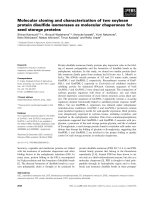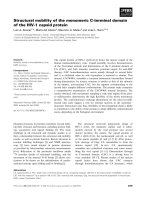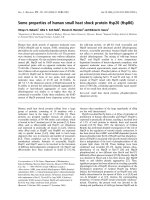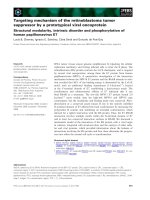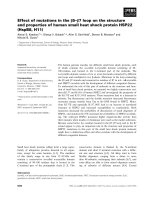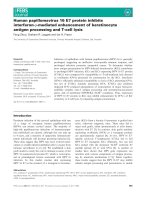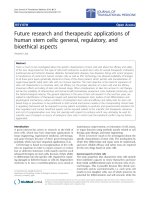Utility of human papillomavirus L1 capsid protein and HPV test as prognostic markers for cervical intraepithelial neoplasia 2+ in women with persistent ASCUS /LSIL cervical cytology
Bạn đang xem bản rút gọn của tài liệu. Xem và tải ngay bản đầy đủ của tài liệu tại đây (484.3 KB, 6 trang )
Int. J. Med. Sci. 2019, Vol. 16
Ivyspring
International Publisher
1096
International Journal of Medical Sciences
2019; 16(8): 1096-1101. doi: 10.7150/ijms.31163
Research Paper
Utility of human papillomavirus L1 capsid protein and
HPV test as prognostic markers for cervical
intraepithelial neoplasia 2+ in women with persistent
ASCUS /LSIL cervical cytology
Eun Young Ki1, Jong Sup Park2, Ahwon Lee3, Tae Jung Kim3, Hyun Tak Jin4, Yong Bok Seo4, Yuki Gen5, Mi
Young Park5, Sung Jong Lee2,6
1.
2.
3.
4.
5.
6.
Department of Obstetrics and Gynecology, Daejeon St. Mary’s Hospital, College of Medicine, The Catholic University of Korea
Department of Obstetrics and Gynecology, Seoul St. Mary’s Hospital, College of Medicine, The Catholic University of Korea, Seoul, Korea
Department of Hospital Pathology, The Catholic University of Korea, College of Medicine, Seoul, Korea
Research Institute, SL BIGEN, Inc., Korea Bio Park, Seongnam, Korea
Department of Obstetrics and Gynecology, St. Vincent’s Hospital, College of Medicine, The Catholic University of Korea, Suwon, Korea
Cancer Research Institute, College of Medicine, The Catholic University of Korea, Seoul, Korea
Corresponding author: Sung Jong Lee. Banpodaero 222, Seochogu, Seoul, Korea; Department of Obstetrics and Gynecology, Seoul St. Mary’s Hospital,
College of Medicine, The Catholic University of Korea, Postal code: 06591; E-mail: ; Phone: +82-10-2785-0948; Fax: +82-2-595-1484
© The author(s). This is an open access article distributed under the terms of the Creative Commons Attribution License ( />See for full terms and conditions.
Received: 2018.11.02; Accepted: 2019.07.17; Published: 2019.08.06
Abstract
Objective: Efficient and highly predictive biomarkers reflecting the prognosis of persistent atypical
squamous cells of unknown significance(ASCUS) and low grade squamous intraepithelial
lesion(LSIL)s are unavailable and need to be developed urgently. We aimed to develop a predictive
model for diagnosis of cervical intraepithelial neoplasia(CIN)2+ by analyzing the
immunocytochemical expression of the HPV L1 capsid protein in patients with persistent ASCUS
and LSIL with a high risk of HPV infection.
Methods: Cervical cytology samples comprising (70 ASCUS and 215 LSIL Pap smears) were
analyzed. Immunocytochemical identification of the HPV L1 capsid protein in cervical cytology
samples was performed. Expression levels of HPV L1 capsid protein in cervical cytology samples
were measured, and the correlation between HPV L1 expression and cervical pathologic diagnosis
was evaluated. The risk for CIN2+ was calculated using the results of immunocytochemistry and the
HPV DNA test.
Results: Negative results for HPV L1 immunochemistry test were more frequently observed in
CIN2+, and expression of the HPV L1 capsid protein was higher in CIN1 or cervicitis (Fisher’s exact
test, p<0.05). Diagnosis rates for CIN2+ were highest for the combination of HPV L1 capsid protein
immunocytochemistry, cytology and HPV test when compared with other combinations (Akaike
information criterion (AIC): 191.7, Schwarz criterion(SC): 206.3, p<0.001).
Conclusion: Absence of HPV L1 capsid expression and presence of HPV type 16 or 18 infection
are reliable predictors of progression to CIN2+ in patients showing persistent ASCUS and LSIL.
Key words: Cervical Intraepithelial Neoplasia, Human papillomavirus 16, Human papillomavirus 18, Low grade
squamous intraepithelial lesion, Atypical squamous cells of unknown significance
Introduction
Human papillomavirus (HPV) is an important
cause of cervical cancer and cervical intraepithelial
neoplasia (CIN), and is associated with 99% of
cervical cancer[1]. In an effort to reduce the incidence
of cervical cancer, cervical cytology has been adopted
as a screening method for cervical disease. Minor
Int. J. Med. Sci. 2019, Vol. 16
abnormal cytology, such as atypical squamous cells of
unknown significance (ASCUS) or low grade
squamous intraepithelial lesions (LSIL), are the
possible manifestations of transient HPV infection.
The American Society for Colposcopy and Cervical
Pathology (ASCCP) recommends observation instead
of intervention due to the high likelihood of
spontaneous regression. However, there are a few
contradictions between ASCCP guidelines and
clinical practice in the management of ASCUS and
LSIL[2].
Despite the high probability of spontaneous
regression of ASCUS and LSIL, persistent minor
cervical abnormalities are occasionally observed in
women with HPV infection[3]. Most patients are
concerned about the possibility of disease progression
to a high grade cervical lesion[4]. Up to 6% of ASCUS
and 30% of LSIL presented with CIN 2+( including
CIN2, CIN3, CIS, AIS, and cervical cancer)[5, 6].
Identification of individuals with ASCUS or LSIL at
high risk for developing CIN 2+ is thus clinically
important. Recently, immunohistochemistry of p16
and Ki-67 was utilized to provide a more accurate
diagnosis of high grade CIN. In the ASCUS-LSIL
triage study (ALTS) trial, the HPV test and
colposcopy were used in combination to enhance the
detection rate of high grade cervical disease[7].
However, this approach did not efficiently predict the
prognosis or persistence of ASCUS or LSIL. The need
to develop a predictive biomarker for ASCUS and
LSIL progression in cervical cytology to provide more
predictive information and reduce discomfort still
remains.
HPV L1, one of the HPV-induced proteins, is a
capsid protein produced at the upper layer of the
differentiated cervical epithelium at the end of the
viral life cycle. HPV is released from cervical
keratinocytes after the assembly of viral proteins[8, 9].
HPV L1 immunocytochemistry in cervical cytology
was found to be a useful predictor of high grade CIN
among patients with ASCUS or LSIL[10, 11].
Therefore, we wanted to combine HPV L1
immunocytochemistry with the cervical cancer
screening triage, which are both used individually in
clinical practice, to evaluate the risk of CIN2+ in
women with persistent ASCUS or LSIL.
The aim of this study was to find the best
predictive model for development of CIN 2+ using
the immunocytochemical expression of the HPV L1
capsid protein in patients with persistent ASCUS, and
LSIL with high risk of HPV infection.
1097
Material and Methods
Study subjects
The medical records of patients who visited the
department of obstetrics and gynecology of Seoul St.
Mary’s Hospital between January 2014 and August
2017 were reviewed. Persistent LSIL or ASCUS was
identified by: 1) diagnosis of ASCUS or LSIL on
follow up cytology after 1 year, and 2) identification in
at least two consecutive cytologic examinations. The
inclusion criteria were as follows: 1) persistent ASCUS
or LSIL, 2) high risk of HPV infection, and 3) presence
of cervical histopathology. The exclusion criteria were
as follows: 1) patients who showed high grade
squamous intraepithelial lesion (HSIL) or atypical
squamous cells with cannot exclude HSIL (ASC-H) at
first cytologic examination, 2) low risk of HPV
infection, 3) patients who were diagnosed with CIN 2
or higher for the first time, and 4) history of cervical
operation or hysterectomy before the study period.
A total of 285 cervical cytology samples (70
ASCUS, and 215 LSIL Pap smears) were analyzed in
this study. Cervical cytology samples were scraped
from the exocervix and endocervix with a cervical
brush. Cytological diagnosis was made following
2001 Bethesda system. HPV genotype was determined
using the HPV DNA chip (PANArrayTM HPV
Genotyping Chip; Pangene CO., Seoul, Korea). The
cervical tissue diagnosis was obtained from the
records of patients who underwent colposcopy
guided biopsy, loop electrosurgical excision
procedure (LEEP), or total hysterectomy. Information
on age, cervical cytology, HPV genotype, expression
status of HPV L1 analyzed by immunocytochemistry,
and pathologic diagnosis of the cervix were collected
for all patients.
The study design, data collection, and analyses
followed the principles of the declaration of Helsinki.
This study was approved by the Institutional Review
Board (IRB) of The Catholic University of Korea
(KC16RISI0388).
Immunocytochemistry
Immunocytochemical identification of the HPV
L1 capsid protein in cervical cytology samples was
performed using the Cytoactive® HPV L1 screening
set (Cytoimmun Diagnostics GmbH, Primasens,
Germany) according to the manufacturer’s protocol.
The coverslip and mounting medium of
Papanicolaou-stained cervical smear slides in xylene
were separated, and the residual xylene on the slides
was removed with alcohol. To retrieve the antigen,
0.01mol/L citrate buffer (pH 6.0) was used, and the
sample was heated in a microwave vacuum
histoprocessor (RHS-1; Milestone, Bergamo, Italy) at a
Int. J. Med. Sci. 2019, Vol. 16
temperature of 121°C for 15 minutes. Slides were kept
at room temperature for 10 minutes to cool.
Subsequently, one droplet of HPV L1 capsid antibody
was applied to the cervical smear slides, and slides
were incubated for 1 hour at room temperature. One
drop of ready -to- use- chromogen solution
(3-amino-9-ethylcarbazole) was applied to the slide
for 5 minutes. Mayer’s hematoxylin counterstain was
then applied. At least 1 positive control slide supplied
by the manufacturer was included in each batch.
Immunocytochemistry was performed using the first
specimen.
Statistical analysis
The expression level of the HPV L1 capsid
protein in cervical cytology samples was calculated,
and the correlation between HPV L1 expression and
cervical pathologic diagnosis was evaluated. HPV L1
expression and other variables used to predict CIN2+
were analyzed using Fisher’s exact test, χ2, and
analysis of model comparison. All analyses were
performed using SAS version 8.0 (SAS institute Inc.,
Cary, NC, USA). P <0.05 was considered statistically
significant. Akaike information criterion (AIC) and
Schwarz criterion (SC) were used to select of the best
model to predict CIN 2+.
Results
The sample population for this study included
information from 70 patients with ASCUS and 215
patients with LSIL. The general characteristics of the
study subjects are shown in Table 1. Among the
patients with persistent ASCUS and LSIL, 244 (85.6%)
were diagnosed with CIN1 or cervicitis and 41 (14.4%)
were diagnosed with CIN2+ based on cervical
histopathology.
Table 2 shows the association between the level
of HPV L1 expression and cervical pathology in
ASCUS and LSIL. Negative results for HPV L1
immunocytochemistry
were
more
frequently
observed in CIN2+, and positive results for HPV L1
capsid protein immunocytochemistry were more
frequent in CIN 1 or cervicitis in both ASCUS and
LSIL groups (Fisher’s exact test, p<0.05). Further risk
of developing CIN2+ was increased five folds in
patients with ASCUS compared to that in patients
showing LSIL when the HPV L1 expression was
absent (Odds ratio (OR) 5.2, 95% confidence interval
(CI) 2.2-12.0, p<0.001) (Table 3). Table 4 shows the
association between the expression of the HPV L1
capsid protein and cervical pathology in patients
infected with HPV types 16 ,18, and other types. In
patients infected with HPV type 16 or 18, frequency of
negative HPV L1 capsid protein expression was
significantly increased compared to HPV L1 positive
1098
CIN2+ (p<0.001). In patients with other HPV types,
HPV L1 negativity was more frequently observed
compared to HPV L1 positivity; however, these
differences were not significant (p=0.182). Based on
previous results, HPV 16 and 18 infection and lack of
HPV L1 protein expression correlated with the
development of CIN 2+.
Table 1. General characteristics of study subjects (N=285)
N (%)
40.7 (20-78)
Mean age(yrs) (range)
Parity
0
1
2
≥3
Cervical cytology
ASCUS
LSIL
Results of HPV L1 immunocytochemistry
Negative
Positive
HPV Type
16 or 18
other
Pathologic diagnosis methods
Cervical biopsy
LEEP / Conization
Hysterectomy
Results of cervical pathology
75 (26.3)
88 (30.9)
92 (32.3)
30 (10.5)
70 (24.6)
215 (75.4)
134 (47.0)
151 (53.0)
158 (55.4)
127 (44.6)
161 (48.2)
144 (43.1)
29 (8.7)
244 (85.6)
≥CIN 2
41 (14.4)
‡
ASCUS: Atypical squamous cells of unknown significance, LSIL: Low grade
squamous intraepithelial lesion, LEEP: Loop electrosurgical excision procedure,
CIN: cervical intraepithelial neoplasia.† It includes chronic cervicitis, CIN1,
koilocytosis, and negative.‡ It includes CIN2, CIN3 , CIS, AIS and cervical cancer.
Table 2. Association between HPV L1 immunocytochemistry and
cervical histopathology according to cervical cytology (N=285)
Cytology
ASCUS
(n=70)
LSIL
(n=215)
L1 capsid protein
immunocytochemistry
P-value
Pathology
L1 negative
< CIN 2
(n=244)
22(46.8)
≥CIN 2
(n=41)
19(82.6)
0.005†
L1 positive
L1 negative
25(53.2)
80(40.6)
4(17.4)
13(72.2)
0.01†
L1 positive
117(59.4)
5(27.8)
Table 3. Comparison of risk of development of CIN2+ between
ASCUS and LSIL according to HPV L1 protein status (N=285)
CIN2+
L1 capsid protein immunochemistry
Cytology
L1 negativity
ASCUS
5.2(2.2-12.0)†
LSIL(ref)
1
P- value
<0.001
†
L1 positivity
3.8(0.9-14.3)†
1
0.051
Odds ratio (95% confidence interval)
Int. J. Med. Sci. 2019, Vol. 16
1099
Table 4. Association between HPV L1 immunocytochemistry and
cervical histopathology according to HPV types (N=285)
HPV
infection
type
16 or 18
HPV L1 capsid protein
immunocytochemistry
L1 negative (n=75)
L1 positive (n=83)
L1 negative (n=59)
Other types L1 positive (n=68)
Pathology
P-value
< CIN 2 ≥ CIN2
(n=244) (n=41)
47(38.5)
28(77.8)
<0.001*
75(61.5)
55(45.1)
67(54.9)
8(22.2)
4(80.0)
1(20.0)
0.182†
Chi-square test, †Fisher’s exact test
*
Table 5. Association between HPV immunocytochemistry with
HPV types and cervical histopathology according to cervical
cytology (N=285)
Cytology HPV infection status and
HPV L1 capsid protein
immunocytochemistry
ASCUS HPV 16 or 18 infection
andHPV L1 protein
negative (n=34)
Others(n=36)†
LSIL
†
HPV 16 or18 infection
and
HPV L1protein
negative(n=41)
Others (n=174)†
OR
(95% CI)
16
(34.1)
6.9 (2.2,
22.2)
18 (78.3)
31
5 (21.7)† 1 (Ref)†
(65.9)†
31
10 (55.6) 6.7 (2.5,
(15.7)
18.3)
P-value
0.001
<0.001
166
8 (44.4)† 1 (Ref)†
(84.3)†
HPV 16 or 18 or other type infection with HPV L1 protein negative or positive
Table 5 demonstrates that the risk of developing
CIN2+ was significantly higher in patients who
lacked HPV L1 expression and HPV 16 or 18
infections compared to any other combination in
women with both ASCUS and LSIL (OR 6.9, 95% CI
2.2-22.2, p=0.001, OR 6.7, 95% CI 2.8-18.3, p< 0.001,
respectively).
Finally, the diagnostic value of various
combinations of cervical cancer screening tools to
predict CIN2+ was calculated (Table 6). A lower value
of AIC and SC was identified as having a higher
diagnostic value. Diagnosis of CIN2+ was the highest
when the combination of HPV L1 capsid protein
immunocytochemistry, cytology and HPV test were
used when compared to other combinations (AIC:
191.7, SC: 206.3, p<0.001).
Discussion
ASCUS and LSIL are generally considered to be
compatible with CIN1. Therefore, a wait and see
approach is generally preferred for the management
of low grade cervical diseases. However, 4% to 36% of
women with persistent ASCUS/LSIL as shown by
cervical
cytology
exhibited
high
grade
histopathology[12, 13]. A key finding of this study is
that a combination of negative results for HPV L1
immunocytochemistry and HPV 16 or 18 infection
could effectively predict development of CIN2+ in
patients with persistent ASCUS and LSIL.
The present study found that HPV L1 negative
cytology samples correlated with the development of
CIN 2+. This finding is consistent with previous
reports that the HPV L1 gene expression is decreased
in higher grades of CIN. Lack of HPV L1 expression in
cervical cytology may be a useful predictive marker
for the detection of higher grade CIN. HPV infection
is categorized into 2 phases; productive and
integrative. The productive phase is characterized by
HPV infection of the basal layer through
micro-wounds in the epithelium, amplification of
HPV viral genes within differentiating epithelial cells
and assembly of the HPV L1 capsomere in the upper
epithelium [14]. Among HPV viral proteins, HPV L1
induces the most striking immune response,
particularly in CD8+ T cells. This finding suggests
that the HPV L1 protein can have a beneficial
immunological role in the spontaneous regression of
cervical disease[15]. Positive expression of the HPV
L1 capsid protein may be a promising indicator of
good prognosis of cervical disease. In contrast, the
HPV L1 protein is not detected when HPV is
integrated into the human genome. Thus, lack of HPV
L1 protein may reflect reduced cellular immune
response
and
thereby
promote
malignant
transformation of cervical epithelial cells[14].
Immunologic evasion may be a critical aspect of high
grade cervical lesions[16, 17]. Lack of HPV L1 protein
expression significantly correlated with high grade
CIN[2]. Even in a study of women under 30 years of
age with mild cervical dysplasia, lack of HPV L1
expression associated with disease progression[18,
19].
Moreover, HPV infection is associated with an
increased risk of development of CIN2+ in patients
with ASCUS and LSIL[20]. In contrast, in the absence
of HPV, the cytologic behavior of ASCUS is similar to
normal cervical cytology samples. The presence of
HPV can be an important pathogenic determinant for
the progression of ASCUS and LSIL. High levels of
the HPV oncoproteins E6 and E7 play important roles
in the progression of cervical disease. HPV E6
inactivates the tumor suppressor, p53, and E7
downregulates pRB [21]. These activities enhance
uncontrolled cell division in cervical disease.
Compared to other high risk HPV infections, HPV 16
infection more closely correlated with the risk of
CIN2+ (31.5% vs 8.6%) in the Addressing THE Need
for Advanced HPV Diagnostic(ATHENA) trial[22].
Additionally, McKenna et al documented that HPV 16
and 18 infections highly correlated with the
development of CIN3[23]. In a 10-year follow-up
study, 17.2% of women with HPV 16 infection and
13.6% of women with HPV 18 showed progression to
CIN3[24]. Similarly, in this study, 22.8% of the women
Int. J. Med. Sci. 2019, Vol. 16
1100
with HPV type 16 or 18 demonstrated CIN2+
histopathology compared to 3.9% of women with
other types of HPV infection. Also, lack of HPV L1
expression correlated with a significantly higher rate
of CIN2+ development than positive HPV L1
expression among patients with HPV 16 or 18
infections. It is possible that the lack of HPV L1
expression is more associated with HPV 16 or 18
infections than other types of HPV infections.
According to previous reports, HPV 16 is closely
related to HPV integration into the host genome and
the absence of HPV L1 expression as determined by
immunohistochemistry[25]. Results of this study
indicate that, when both HPV infection and absent
HPV L1 expression are observed, patients with
persistent ASCUS progressed to CIN2+ more
frequently than patients with persistent LSIL. A
similar trend was seen in an observational study in
which women with both HPV infection and persistent
ASCUS were at higher risk than women with
persistent LSIL for the development of CIN3+ (6.8%
vs 5.2%, p< 0.001) and cancer (0.4% vs 0.16%, p=0.04)
between the ages 30 to 64[20]. Additionally, the
combination of absent HPV L1 expression and HPV
integration could significantly predict progression to
CIN2+ among patients with ASCUS and LSIL. For this
reason, colposcopic examination was recommended
by the ASCCP for women 30 years of age or older
with HPV 16 or 18 infection regardless of cytologic
pathology[26].
Observational data for women with persistent
ASCUS and LSIL demonstrated that the risk of
progression to CIN 2+ increases 1~2% annually[20].
Based on our experience in the gynecologic clinic,
patients who were initially diagnosed with minor
abnormal cervical cytology, they were compliant with
the doctor’s recommendations with a mild degree of
fear. On the contrary, patients who presented with
persistent ASCUS and LSIL typically expressed deep
concern regarding the risk of progression to a high
grade disease[27].
Despite the high rate of spontaneous regression
of ASCUS/LSIL, patients may experience substantial
apprehension about the oncogenic potential of HPV
infection, risks associated with low grade cervical
abnormality, abnormal colposcopic findings, and
additional invasive procedures. Observational
management of patients with ASCUS/LSIL can be felt
differently among doctors and patients. In general,
gynecologists regard observation as way to avoid
unnecessary treatment of low grade cervical
abnormalities. Patients tend to worry about the
possibility that delayed treatment may accelerate the
progression to cervical cancers. If cervical biomarkers
can offer additional confirmative information on the
prognosis of persistent ASCUS and LSIL, the patient’s
levels of apprehension may be reduced.
The present study investigated the capability of
immunocytochemistry on cervical cytology samples
for the early prediction of high grade cervical disease
among women with persistent ASCUS and LSIL. The
HPV L1 expression level may provide information on
whether observation or treatment is more appropriate
for patients with persistent cervical abnormalities.
The present results show that lack of HPV L1
expression and presence of HPV type 16 or 18
infection can accurately predict progression to CIN2+
in women showing persistent ASCUS and LSIL. In
conclusion, HPV L1 immunocytochemistry and the
HPV type test can predict CIN2+ in women with
persistent ASCUS or LSIL.
Acknowledgements
This research was supported by a grant of the
Korea Health Technology R&D Project under the
Korea Health Industry Development Institute
(KHIDI), funded by the Ministry of Health & Welfare,
Republic of Korea (grant number: HI15C-2915) and
the financial support of the Catholic Medical Center
Research Foundation made in the program year of
2018.
Table 6. Diagnostic value to predict CIN2+ using combinations of cervical cancer screening tools (N=285)*
Model
Cytology+L1 protein+ HPV
Cytology+L1 protein
Cytology+ HPV
Cytology
Intercept only
Cytology
ASCUS (n=70)
OR (95% CI)
2.93 (1.37-6.29)
4.83 (2.35-9.91)
3.3 (1.58-6.88)
5.36 (2.68-10.72)
Cytology
LSIL
Positive (n=151) Negative
(n=215)
(n=134)
OR (95% CI)
1
0.19 (0.1-0.4)
1
1
0.2 (0.1-0.5)
1
1
1
HPV test
16 or 18 (n=158)
AIC†
SC‡
Backward Forward
P-value
P-value
191.7
203.1
207.5
216.4
236.8
206.3
214.0
218.4
223.7
234.8
0.0002
<0.0001
<0.0001
<0.0001
<0.0001
Others
(n=127)
OR (95% CI)
5.6 (1.9-15.6)
1
4.7 (1.7-12.9)
1
<0.0001
<0.0001
<0.0001
<0.0001
<0.0001
Model comparison, †Akaike information criterion, ‡Schwarz criterion
*
Int. J. Med. Sci. 2019, Vol. 16
Ethics Committee Approval and Patient
Consent
This study was approved by the Institutional
Review Board (IRB) of The Catholic University of
Korea (KC16RISI0388). Written informed consent was
obtained from all study subjects.
Competing Interests
The authors have declared that no competing
interest exists.
References
1.
2.
3.
4.
5.
6.
7.
8.
9.
10.
11.
12.
13.
14.
15.
16.
17.
18.
19.
20.
21.
HoshikawaS, Sano T, Yoshida T, et al. Immunohistological analysis of HPV L1
capsid protein and p16 protein in low-grade dysplastic lesions of the uterine
cervix. Pathol Res Pract. 2010; 206(12): 816-20.
Massad LS, Einstein MH, Huh WK, et al. 2012 updated consensus guidelines
for the management of abnormal cervical cancer screening tests and cancer
precursors. Obstet Gynecol. 2013; 121(4): 829-46.
Gerber S, De Grandi P, Petignat P, et al. Colposcopic evaluation after a repeat
atypical squamous cells of undetermined signifcance (ASCUS) smear. Int J
Gynecol Obstet. 2001; 75(3): 251-5.
SorbyeSW, Arbyn M, Fismen S, et al. HPV E6/E7 mRNA testing is more
specific than cytology in post-colposcopy follow-up of women with negative
cervical biopsy. PLoS One. 2011; 6(10): e26022.
Wanram S, Limpaiboon T, Leelayuwat C, et al. The use of viral load as a
surrogate marker in predicting disease progression for patients with early
invasive cervical cancer with integrated human papillomavirus type 16. Am J
Obstet Gynecol. 2009; 201(1): 79 e1-7.
Boulet GA, Benoy IH, Depuydt CE, et al. Human papillomavirus 16 load and
E2/E6 ratio in HPV16-positive women: biomarkers for cervical intraepithelial
neoplasia >or=2 in a liquid-based cytology setting? Cancer Epidemiol
Biomarkers Prev. 2009; 18(11): 2992-9.
Shiffman M, Solomon D. Findings to date from the ASCUS-LSIL triage
study(ALTS). Arch Pathol Lab Med. 2003; 127: 946-9.
Melsheimer P, Kaul S, Dobeck S, et al. Immunocytochemical detection of HPV
high risk type L1 capsid protein in LSIL and HSIL as compared with detection
of HPV L1 DNA. Acta Cytol, 2003; 47(2): 124-8.
zur HausenH. Papillomaviruses and cancer: from basic studies to clinical
application. Nat Rev Cancer. 2002; 2(5): 342-50.
Lee SJ, Lee AW, Kang CS, et al. Clinicopathological implications of human
papilloma virus (HPV) L1 capsid protein immunoreactivity in HPV16-positive
cervical cytology. Int J Med Sci. 2014;11(1): 80-6.
Lee SJ, Lee AW, Kim TJ, et al. Correlation between immunocytochemistry of
human papilloma virus L1 capsid protein and behavior of low-grade cervical
cytology in Korean women. J Obstet Gynaecol Res. 2011; 37(9): 1222-8.
Rinku S, Vijaylaksmi B, Anupama J, et al. A proespecitve study of 86 cases of
ASCUS(atypical squamous cells of undetermined signifcance) over two year. J
Obstet Gynecol India. 2007; 57(1): 73-6.
NogaraPR, Manfroni LA,Consolaro ME. Frequency of cervical intraepithelial
neoplasia grade II or worse in women with a persistent low-grade squamous
intraepithelial lesion seen by Papanicolaou smears. Arch Gynecol Obstet. 2013;
288(5): 1125-30.
SchiffmanM, Doorbar J, Wentzensen N, et al. Carcinogenic human
papillomavirus infection. Nat Rev Dis Primers. 2016; 2: 16086.
Steele JC, Roberts S, Rookes SM, et al. Detection of CD4+- and CD8+-T-Cell
Responses to Human Papillomavirus Type 1 Antigens Expressed at Various
Stages of the Virus Life Cycle by Using an Enzyme-Linked Immunospot Assay
of Gamma Interferon Release. J Virol. 2002; 76(12): 6027-36.
BoccardoE,Lepique AP,Villa LL. The role of inflammation in HPV
carcinogenesis. Carcinogenesis. 2010; 31(11): 1905-12.
Lee SJ, Yang A, Wu TC, et al. Immunotherapy for human
papillomavirus-associated disease and cervical cancer: review of clinical and
translational research. J Gynecol Oncol. 2016; 27(5): e51.
Choi YS, Kang WD, Kim SM, et al. Human papillomavirus L1 capsid protein
and human papillomavirus type 16 as prognostic markers in cervical
intraepithelial neoplasia 1. Int J Gynecol Cancer. 2010; 20(2): 288-93.
Rauber D, Mehlhom G, Fasching PA, et al. Prognostic significance of the
detection of human papilloma virus L1 protein in smears of mild to moderate
cervical intraepithelial lesions. Eur J Obstet Gynecol Reprod Biol. 2008; 140(2):
258-62.
Katki HA, Schiffman M, Castle PE, et al. Five-year risks of CIN3+ and cervical
cancer among women with HPV testing of ASCUS pap results. J Low Genit
Tract Dis. 2013; 17(5): S36-42.
YugawaT, Kiyono T. Molecular mechanisms of cervical carcinogenesis by
high-risk human papillomaviruses: novel functions of E6 and E7 oncoproteins.
Rev Med Virol. 2009; 19(2): 97-113.
1101
22. Li SR, Wang ZM, Wang YH, et al. Value of PAX1 Methylation Analysis by
MS-HRM in the Triage of Atypical Squamous Cells of Undetermined
Significance. Asian Pac J Cancer Prev., 2015; 16(14): 5843-6.
23. McKennaM, McMenamin M, McDowell A. HPV16 and HPV18 genotyping
triage in young women with borderline cytology or mild dyskaryosis: effect of
age on genotype-specific risk of high-grade CIN. Cytopathology. 2016; 27(4):
261-8.
24. Resnick RM, Cornellssen MT, Wright DK, et al. Detection and typing of
human papillomavirus in archival cervical cancer specimens by DNA
amplification woth consensus primers. J Natl Cancer Inst. 1990; 82(18):
1477-87.
25. Choi YJ, Lee A, Kim TJ, et al. E2/E6 ratio and L1 immunoreactivity as
biomarkers to determine HPV16-positive high-grade squamous intraepithelial
lesions (CIN2 and 3) and cervical squamous cell carcinoma. J Gynecol Oncol.
2018; 29(3): e38.
26. Haltas H, Bayrak R, Yenidunya S, et al. The immunohistochemical detection of
P16 and HPV L1 capsid protein on cell block sections from residual PApSpin
liquid- based gynecology cytology specimens as a diagnostic and prognostic
tool. Eur Rev Med Pharmacol Sci. 2012; 16(11): 1588-95.
27. Kwan TT, Cheung AN, Lo SS, et al. Psychological burden of testing positive
for high-risk human papillomavirus on women with atypical cervical
cytology: a prospective study. Acta Obstet Gynecol Scand. 2011; 90(5): 445-51.



